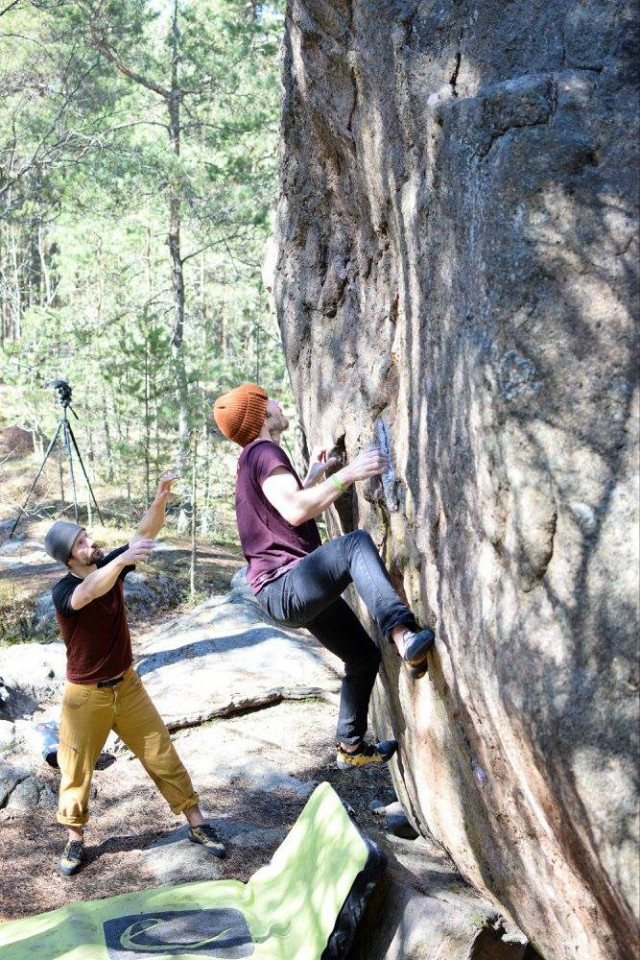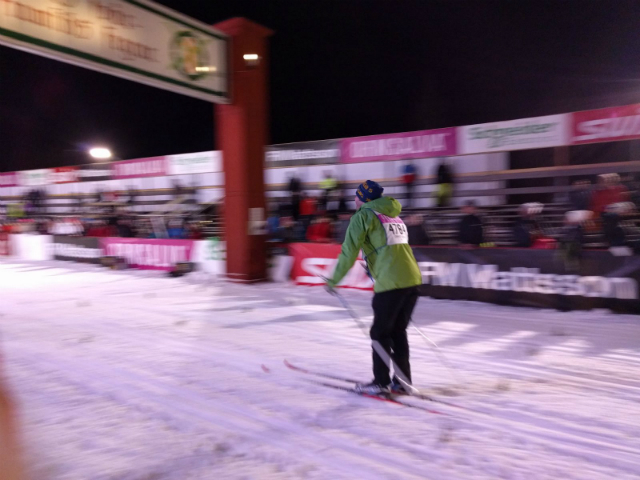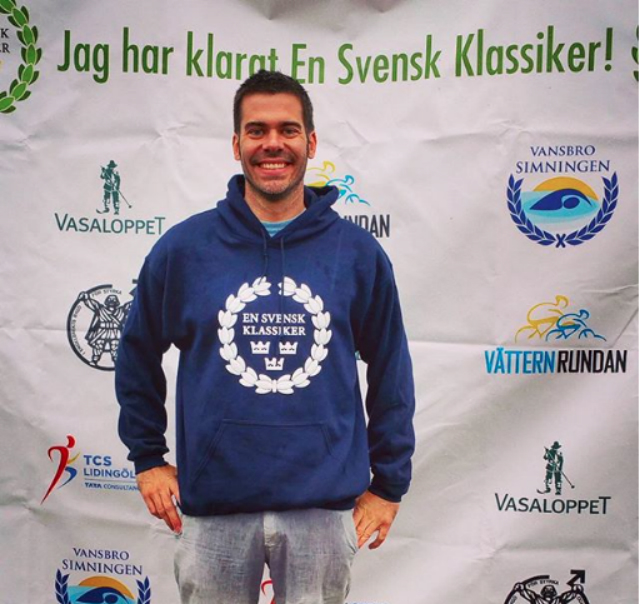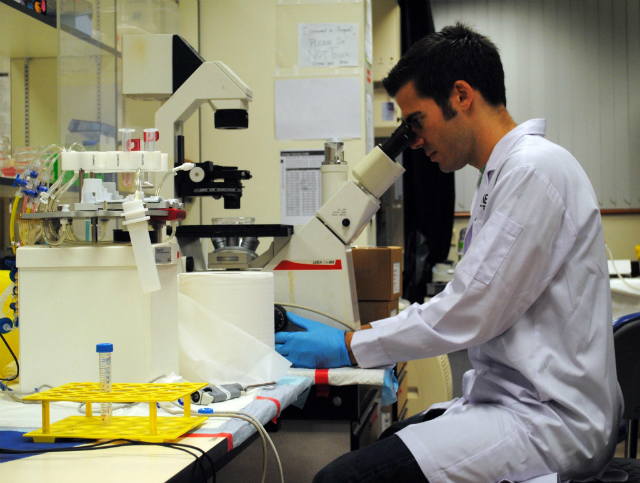'Sweden feels like a different country each season'

Meet the American who's climbed the highest peak in Sweden – and wants more. Biomedical engineer Chris Grigsby divides his time between a lab and the great outdoors.
Grigsby, 35, moved to Stockholm in January 2016 to take up a position as a post-doctoral researcher at the Karolinska Institute, working in biomaterials and regenerative medicine.
A biomedical engineer, he is working on cell reprogramming, turning cells which are not neurons into neurons, aiming to treat neurodegenerative disease. It's "like stem cells, but not", he says.
But he doesn't spend all his hours in the lab. An avid rock climber and runner, Grigsby has found in Sweden a balance between urban spaces and nature. Having moved to Stockholm from New York City, easy access to nature is his favourite thing about life here. He says pursuing outdoor activities such as rock climbing isn't exactly straightforward in the Big Apple:
"In order to go climbing there you have to drive to the airport, rent a car for $300, drive three hours to get to a place outside the city, pay more fees to enter the campground, and then you can climb for a day."
In Sweden, on the other hand, "you can pretty much take the bus or a train in any direction outside the city and find lots of hiking trails and rocks to climb, and water to swim in or kayak."

Grigsby climbing in Finland on a trip organized by the Solna Klätterklubb. Photo: Hampus Boësen/Private
Access to nature and conservation are highly valued in Sweden. As of late 2016, 85 percent of Swedes lived within 5km of a nature park, nature reserve, or conservation area – and a striking 98 percent within 10km. Forests cover almost 70 percent of Swedish land territory, and after the first national parks of Europe were created in Sweden in 1909, the country now boasts 12,474 protected areas.
"I think Swedes also in general are pretty fit as a society, so there's a lot of enthusiasm for any sort of outdoor activities," says Grigsby, whose own passion for the outdoors has led him all over Sweden, starting right outside Stockholm.
Last summer, he entered the world's largest cross-country running competition, Lidingöloppet, which takes place every September in Lidingö, Stockholm. Then, through social media, he found out that Lidingöloppet was part of a larger event, the Swedish Classic.
It consists of the 30km race in Lidingö, a 90km cross-country ski race (called the "Vasa race" in Sweden), a 300km cycle race, and a 3km swim race, to be completed in a 12-month period. The point of the Classic is to keep people active and training all year round, motivated by the different challenges.
"The whole point of this, is that all the races are designed to be recreational. They're not designed to be super competitive, they're supposed to be a way to get people off the couch and start training, within reach for anyone who trains."
"I've always liked doing endurance sports like that, so I thought I'd sign up and do them all", says Grigsby.
But it wasn't all that easy. After Lidingöloppet, the next event on the calendar was the ski race in Dalarna. "I had never cross-country skied before, and it hadn't been a great snow year, so there weren't too many opportunities for training in Stockholm. And I wasn't aware of the existence of roller skis either, which I guess you can use to train with no snow. I spent maybe an hour or two on skis in Hellasgården in Stockholm before the race."
Undeterred, Grigsby "bought some skis on Blocket [a Swedish buy-and-sell site similar to Craigslist], took the train up there, and survived – barely. And I think I beat at least three other Americans, so I wasn't last."
He says at every checkpoint during race there is a cut-off time. "If you don't pass there before that time, they kick you off the course and send you home."
And at one point during the race, he was ready to be sent home: "I thought I was too slow, and I was ready to be cut off when I got there, but in my exhaustion I just read my watch wrong, I think, because when I got there I realized I still had another hour or two. So I got to drink some more blueberry soup and keep going."

Chris Grigsby completing the Vasaloppet Öppet Spår in Mora, Sweden. Photo: Hanna Barriga/Private
Grigsby finished the ski race, and all other races, and completed his Swedish Classic. "After you've completed all four events in a 12-month period you can go on their website and register your completion and they'll give you a number."
"All the races, besides the Lidingöloppet, are in Dalarna, which is Swedish heartland. It's cool to be part of something that's so traditional, and I guess, classic," he says, noting that most of the participants in the events are Swedish.
Would he do it again? "I know there's a special award if you complete all the races with a total time below a certain threshold", he says, referring to the Super Classics Trophy. "So that might be my next goal. We'll see."

Grigsby after completing Vansbrosimningen, the last leg of the Classic in Vansbro. Photo: Private
"Oh another thing I did", he says, unassuming, "was the Fjällräven Classic". The Fjällräven Classic is a trek on a 110km section of the Kungsleden trail up in Lapland, going from Nikkaluokta to Abisko, organized as the name suggests by Swedish outdoor wear company Fjällräven.
Up there, he recalls, "you get all four seasons every day – you get snow, hail, rain and sunshine, all of it."
And if hiking in Lapland, seeing reindeer and experiencing the wild climate of the Arctic were not enough, Grigsby took on another challenge during the Classic:
"I took a detour on the second day and climbed Kebnekaise, which is Sweden's tallest peak. Despite it not being that tall, it was pretty treacherous. I've climbed a couple of 14,000 foot peaks in the States, and this one, I had some sketchy moments up there. It was legit winter up at the top, even though it was August. So that was also a good time."
He camped half-way up the mountain and had an early start on the climb. "I passed some people who were going up on my way down, but I think I was the first one on top that day."
He really enjoyed the experience – and the big party at the finish line in Abisko – and is already making plans to go back up north. "I haven't booked it yet, but I want to go back up there in the winter, because I still haven't seen the northern lights, and I think it's beautiful up there so I'd like to go check it out during other seasons."
READ ALSO: Five top tips for climbing Kebnekaise
The Classic was a good first step for getting to know the area, and organized events like these can help those who are intimidated by going to the Arctic Circle for the first time by themselves, as he was. "But now that I've been up there, I'd totally go back and hike there again, but not as part of the event. I'll probably just go up by myself or with anyone who'd like to go have a little bit more solitude."
The harsh Arctic winter does not intimidate Grigsby, who says he likes bad weather and snow. "As long as you have warm clothes, it's not a problem."
Having moved to Stockholm in the middle of winter, the cold and the darkness were the first things he noticed. Now, he says the changing weather is one of his favourite things about living in Sweden, as the distinct seasons help "keep things fresh". "It feels like a different city, a different country, each season."
So does he see himself staying in Sweden? He doesn't know. He found in Sweden the mix of good culture and good scientific infrastructure he was looking for, but he is living the "post-doc lifestyle" – one year at a time. His current fellowship ends in January, but he is staying on for at least another year.

Grigsby at work. Photo: Private
He likes Swedes' healthy cultural approach to work. In the US, "when you meet your friends after work, inevitably the first discussion you have is how hard you worked that week, how many hours you worked that week, how much stress you're under". In Sweden, that first conversation is usually "about the weather, or what your next holiday is".
And he wants to work on his Swedish more as well. After stopping SFI (Swedish for Immigrants) in the summer, he is in the process of re-enrolling.
Becoming fluent in Swedish will help him pursue another one of his passions. For ten years in the US, Grigsby volunteered at fire departments and ambulance services as an Emergency Medical Technician, or EMT. Seeing the clinical side of medicine, rather than the research side he sees at work, was one of his favourite things. As for volunteering in Sweden? "If I do get my Swedish skills up to an appropriate level."
Comments
See Also
Grigsby, 35, moved to Stockholm in January 2016 to take up a position as a post-doctoral researcher at the Karolinska Institute, working in biomaterials and regenerative medicine.
A biomedical engineer, he is working on cell reprogramming, turning cells which are not neurons into neurons, aiming to treat neurodegenerative disease. It's "like stem cells, but not", he says.
But he doesn't spend all his hours in the lab. An avid rock climber and runner, Grigsby has found in Sweden a balance between urban spaces and nature. Having moved to Stockholm from New York City, easy access to nature is his favourite thing about life here. He says pursuing outdoor activities such as rock climbing isn't exactly straightforward in the Big Apple:
"In order to go climbing there you have to drive to the airport, rent a car for $300, drive three hours to get to a place outside the city, pay more fees to enter the campground, and then you can climb for a day."
In Sweden, on the other hand, "you can pretty much take the bus or a train in any direction outside the city and find lots of hiking trails and rocks to climb, and water to swim in or kayak."

Grigsby climbing in Finland on a trip organized by the Solna Klätterklubb. Photo: Hampus Boësen/Private
Access to nature and conservation are highly valued in Sweden. As of late 2016, 85 percent of Swedes lived within 5km of a nature park, nature reserve, or conservation area – and a striking 98 percent within 10km. Forests cover almost 70 percent of Swedish land territory, and after the first national parks of Europe were created in Sweden in 1909, the country now boasts 12,474 protected areas.
"I think Swedes also in general are pretty fit as a society, so there's a lot of enthusiasm for any sort of outdoor activities," says Grigsby, whose own passion for the outdoors has led him all over Sweden, starting right outside Stockholm.
Last summer, he entered the world's largest cross-country running competition, Lidingöloppet, which takes place every September in Lidingö, Stockholm. Then, through social media, he found out that Lidingöloppet was part of a larger event, the Swedish Classic.
It consists of the 30km race in Lidingö, a 90km cross-country ski race (called the "Vasa race" in Sweden), a 300km cycle race, and a 3km swim race, to be completed in a 12-month period. The point of the Classic is to keep people active and training all year round, motivated by the different challenges.
"The whole point of this, is that all the races are designed to be recreational. They're not designed to be super competitive, they're supposed to be a way to get people off the couch and start training, within reach for anyone who trains."
"I've always liked doing endurance sports like that, so I thought I'd sign up and do them all", says Grigsby.
But it wasn't all that easy. After Lidingöloppet, the next event on the calendar was the ski race in Dalarna. "I had never cross-country skied before, and it hadn't been a great snow year, so there weren't too many opportunities for training in Stockholm. And I wasn't aware of the existence of roller skis either, which I guess you can use to train with no snow. I spent maybe an hour or two on skis in Hellasgården in Stockholm before the race."
Undeterred, Grigsby "bought some skis on Blocket [a Swedish buy-and-sell site similar to Craigslist], took the train up there, and survived – barely. And I think I beat at least three other Americans, so I wasn't last."
He says at every checkpoint during race there is a cut-off time. "If you don't pass there before that time, they kick you off the course and send you home."
And at one point during the race, he was ready to be sent home: "I thought I was too slow, and I was ready to be cut off when I got there, but in my exhaustion I just read my watch wrong, I think, because when I got there I realized I still had another hour or two. So I got to drink some more blueberry soup and keep going."

Chris Grigsby completing the Vasaloppet Öppet Spår in Mora, Sweden. Photo: Hanna Barriga/Private
Grigsby finished the ski race, and all other races, and completed his Swedish Classic. "After you've completed all four events in a 12-month period you can go on their website and register your completion and they'll give you a number."
"All the races, besides the Lidingöloppet, are in Dalarna, which is Swedish heartland. It's cool to be part of something that's so traditional, and I guess, classic," he says, noting that most of the participants in the events are Swedish.
Would he do it again? "I know there's a special award if you complete all the races with a total time below a certain threshold", he says, referring to the Super Classics Trophy. "So that might be my next goal. We'll see."

Grigsby after completing Vansbrosimningen, the last leg of the Classic in Vansbro. Photo: Private
"Oh another thing I did", he says, unassuming, "was the Fjällräven Classic". The Fjällräven Classic is a trek on a 110km section of the Kungsleden trail up in Lapland, going from Nikkaluokta to Abisko, organized as the name suggests by Swedish outdoor wear company Fjällräven.
Up there, he recalls, "you get all four seasons every day – you get snow, hail, rain and sunshine, all of it."
And if hiking in Lapland, seeing reindeer and experiencing the wild climate of the Arctic were not enough, Grigsby took on another challenge during the Classic:
"I took a detour on the second day and climbed Kebnekaise, which is Sweden's tallest peak. Despite it not being that tall, it was pretty treacherous. I've climbed a couple of 14,000 foot peaks in the States, and this one, I had some sketchy moments up there. It was legit winter up at the top, even though it was August. So that was also a good time."
He camped half-way up the mountain and had an early start on the climb. "I passed some people who were going up on my way down, but I think I was the first one on top that day."
He really enjoyed the experience – and the big party at the finish line in Abisko – and is already making plans to go back up north. "I haven't booked it yet, but I want to go back up there in the winter, because I still haven't seen the northern lights, and I think it's beautiful up there so I'd like to go check it out during other seasons."
READ ALSO: Five top tips for climbing Kebnekaise
The Classic was a good first step for getting to know the area, and organized events like these can help those who are intimidated by going to the Arctic Circle for the first time by themselves, as he was. "But now that I've been up there, I'd totally go back and hike there again, but not as part of the event. I'll probably just go up by myself or with anyone who'd like to go have a little bit more solitude."
The harsh Arctic winter does not intimidate Grigsby, who says he likes bad weather and snow. "As long as you have warm clothes, it's not a problem."
Having moved to Stockholm in the middle of winter, the cold and the darkness were the first things he noticed. Now, he says the changing weather is one of his favourite things about living in Sweden, as the distinct seasons help "keep things fresh". "It feels like a different city, a different country, each season."
So does he see himself staying in Sweden? He doesn't know. He found in Sweden the mix of good culture and good scientific infrastructure he was looking for, but he is living the "post-doc lifestyle" – one year at a time. His current fellowship ends in January, but he is staying on for at least another year.

Grigsby at work. Photo: Private
He likes Swedes' healthy cultural approach to work. In the US, "when you meet your friends after work, inevitably the first discussion you have is how hard you worked that week, how many hours you worked that week, how much stress you're under". In Sweden, that first conversation is usually "about the weather, or what your next holiday is".
And he wants to work on his Swedish more as well. After stopping SFI (Swedish for Immigrants) in the summer, he is in the process of re-enrolling.
Becoming fluent in Swedish will help him pursue another one of his passions. For ten years in the US, Grigsby volunteered at fire departments and ambulance services as an Emergency Medical Technician, or EMT. Seeing the clinical side of medicine, rather than the research side he sees at work, was one of his favourite things. As for volunteering in Sweden? "If I do get my Swedish skills up to an appropriate level."
Join the conversation in our comments section below. Share your own views and experience and if you have a question or suggestion for our journalists then email us at [email protected].
Please keep comments civil, constructive and on topic – and make sure to read our terms of use before getting involved.
Please log in here to leave a comment.